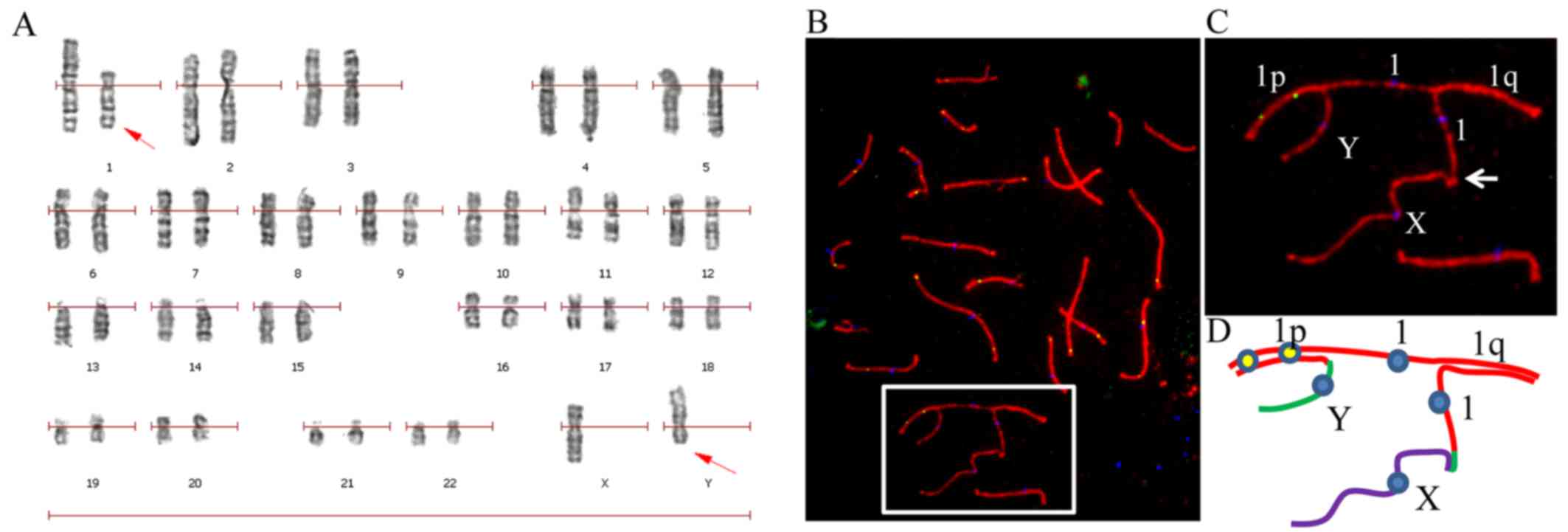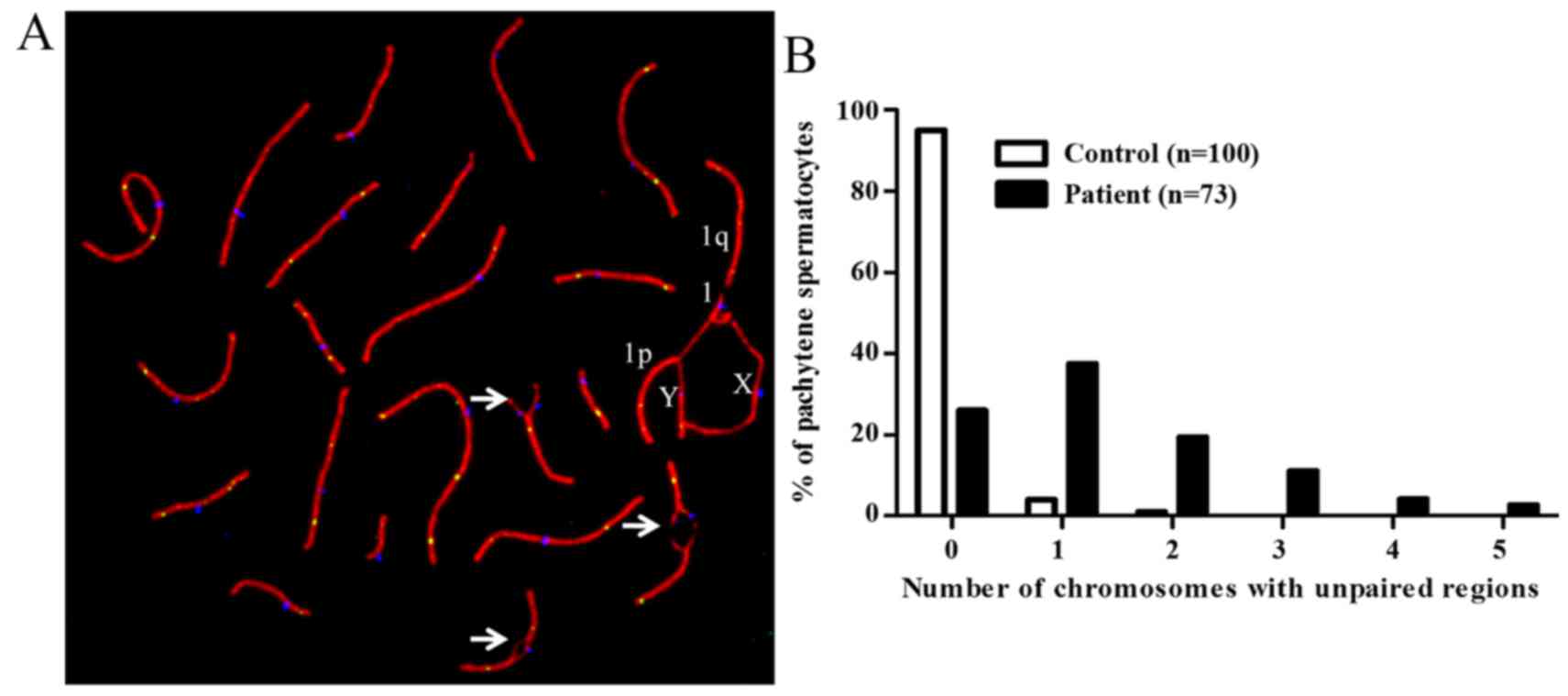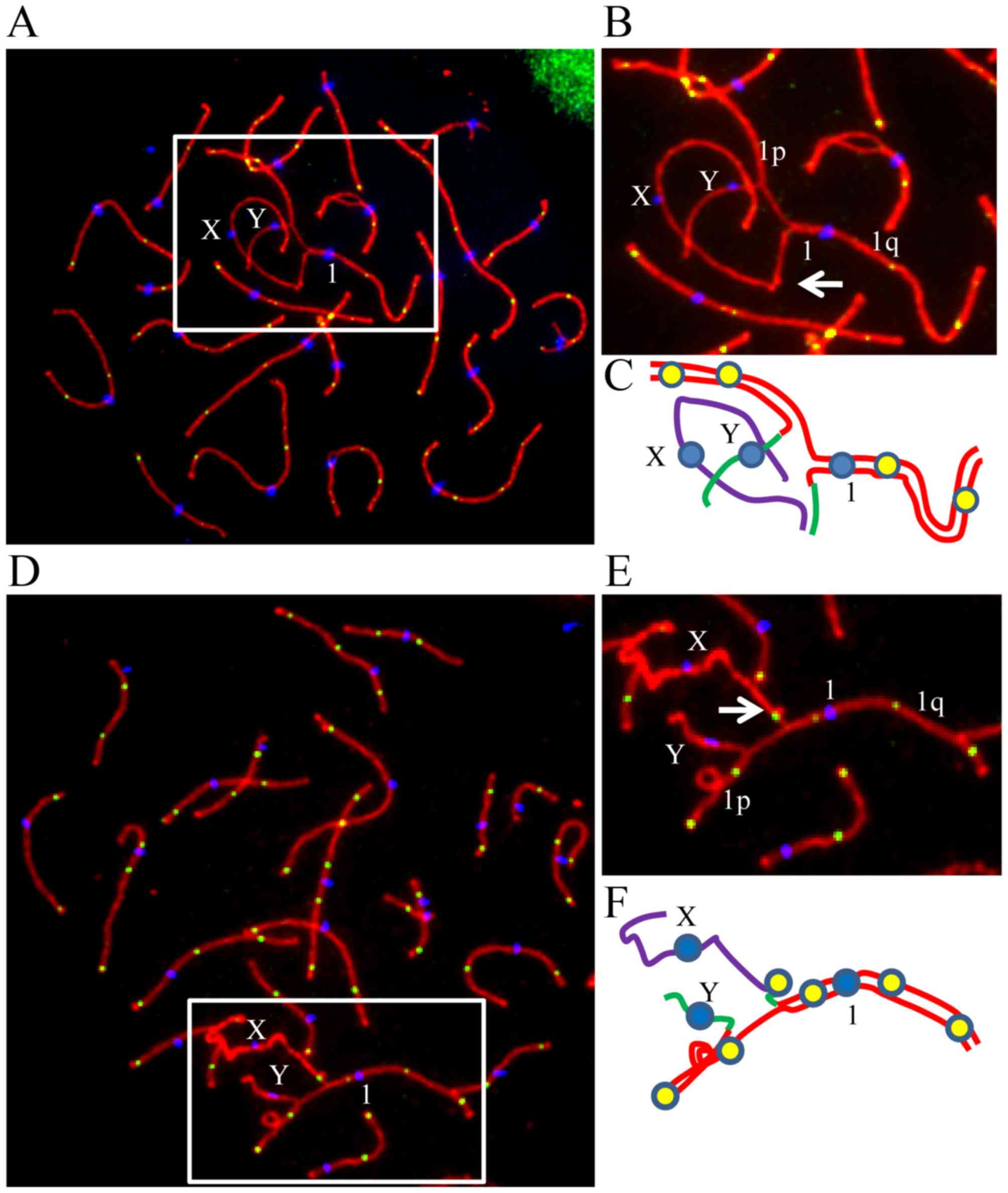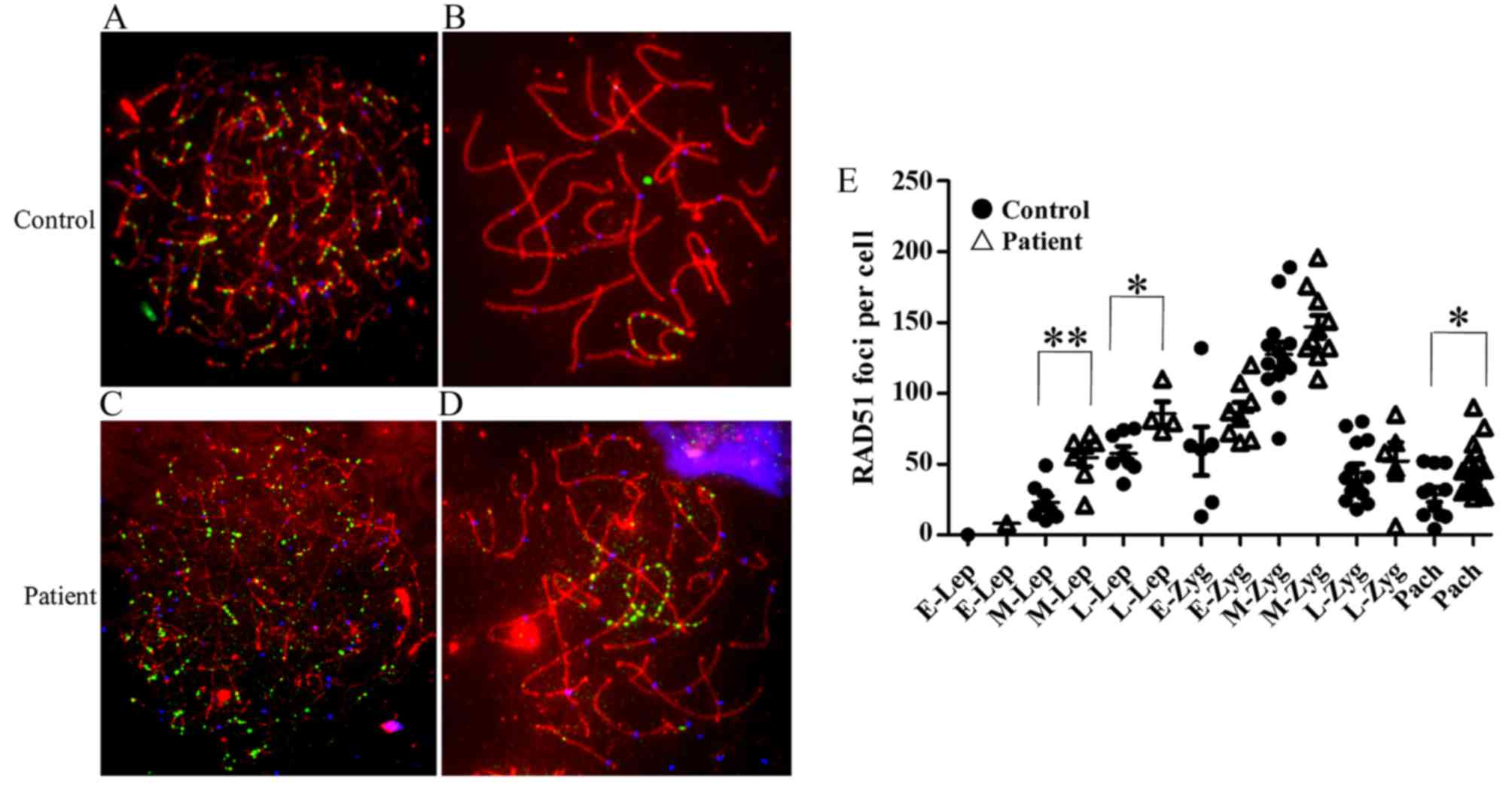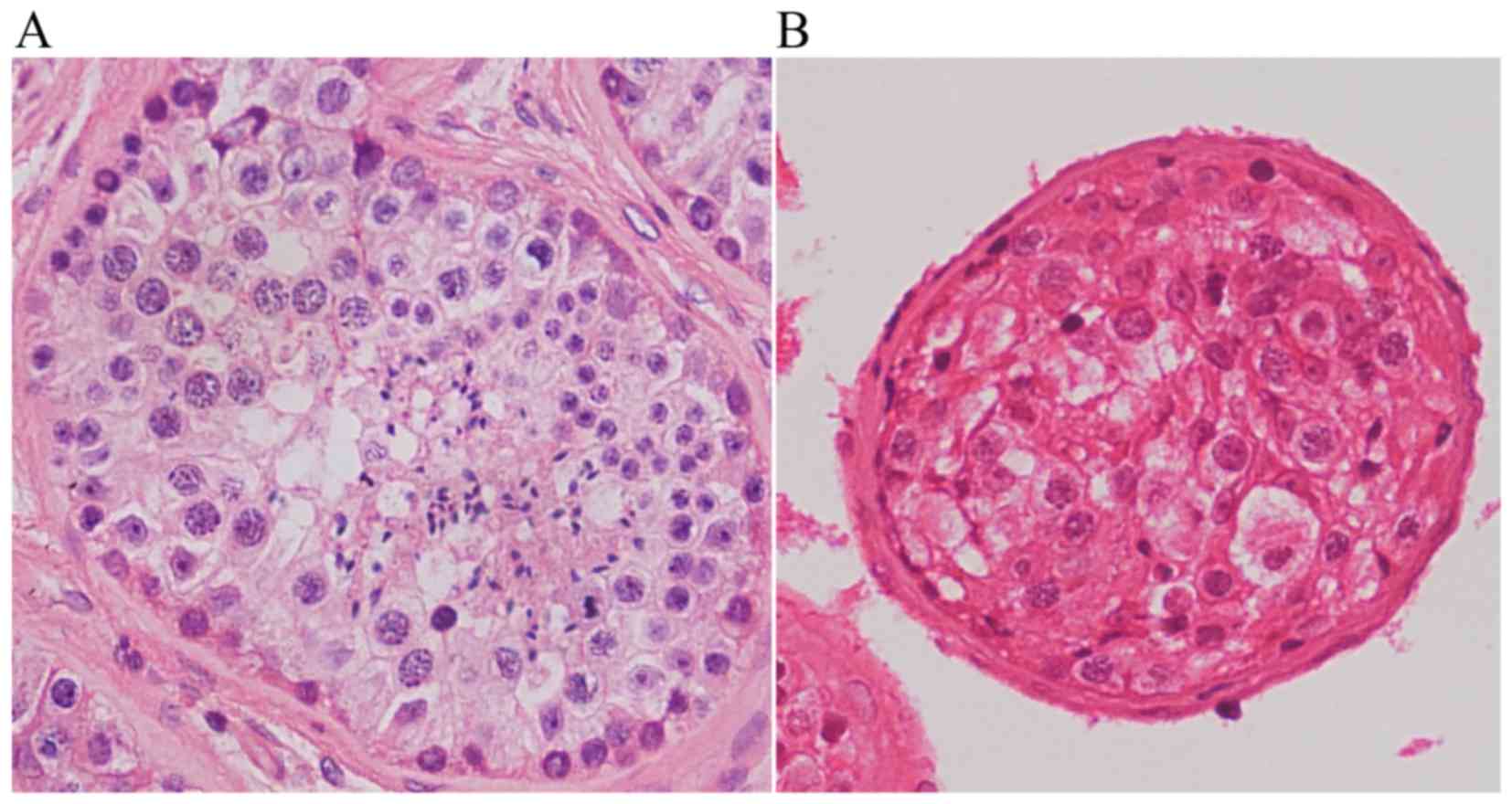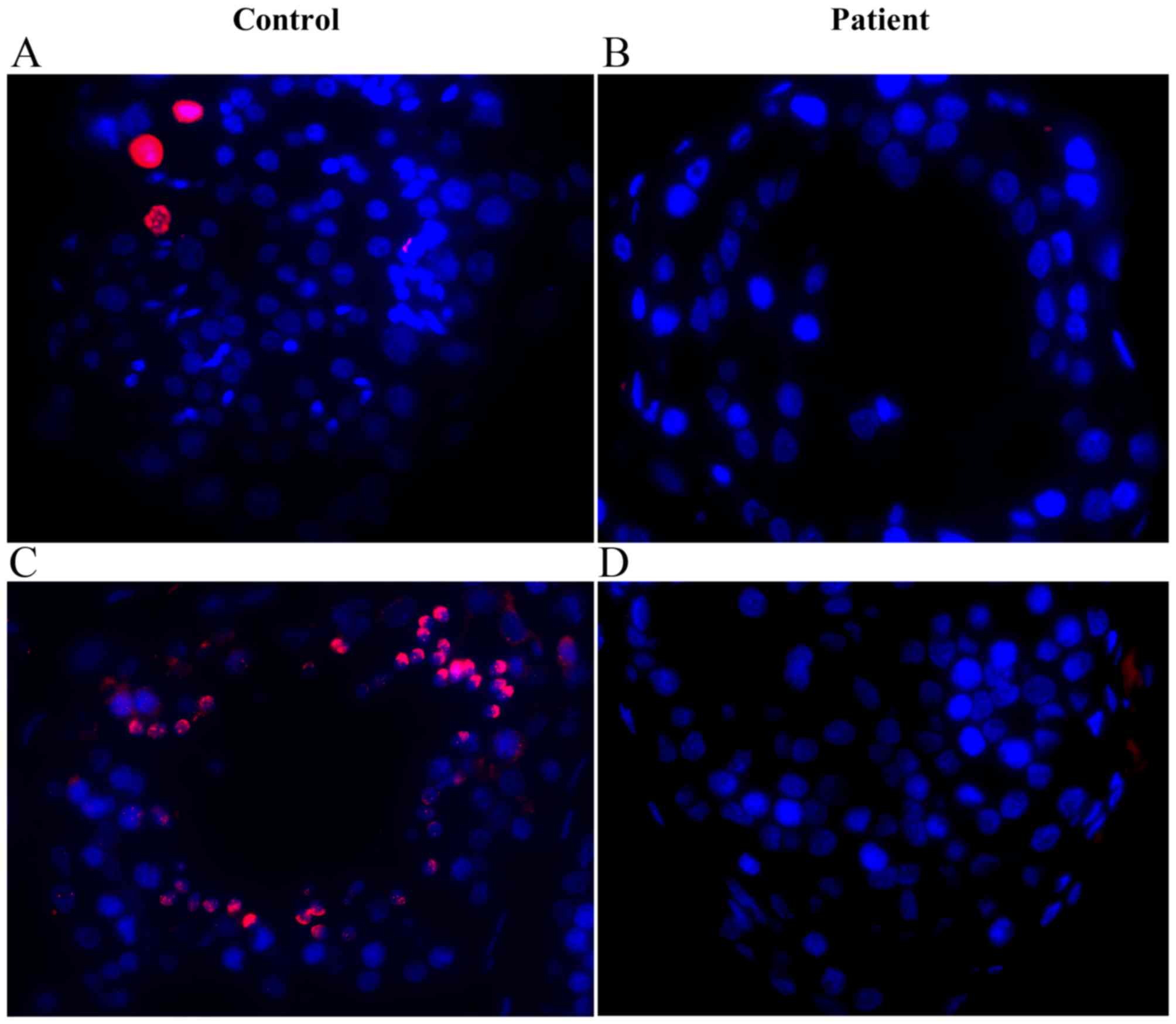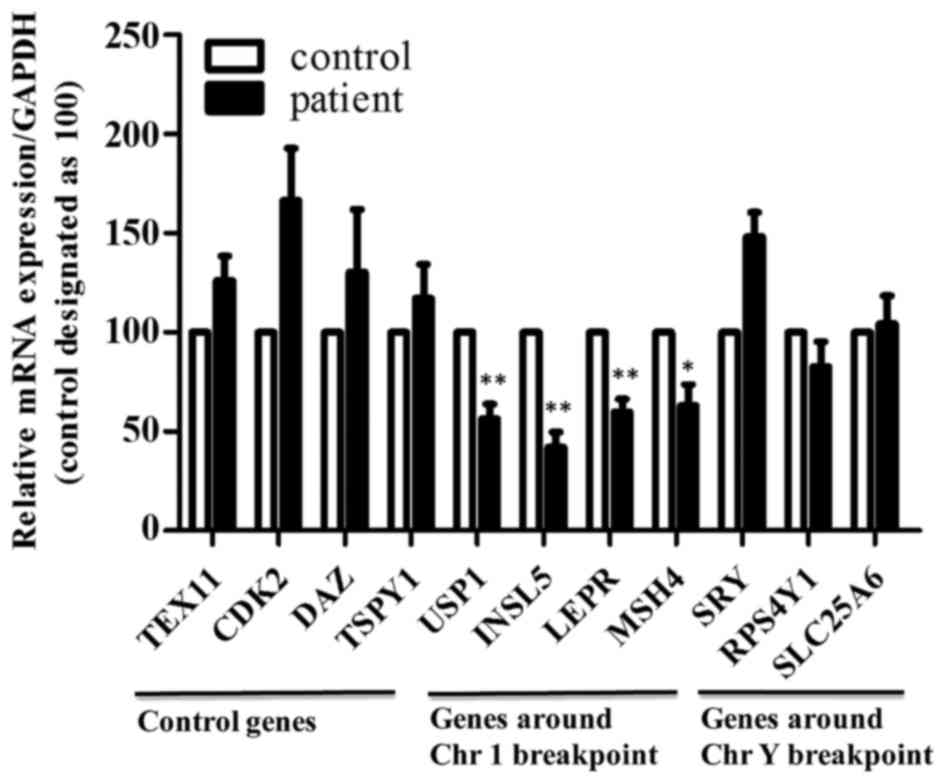Meiotic defects and decreased expression of genes located around the chromosomal breakpoint in the testis of a patient with a novel 46,X,t(Y;1)(p11.3;p31) translocation
- Authors:
- Published online on: June 14, 2017 https://doi.org/10.3892/ijmm.2017.3029
- Pages: 367-377
-
Copyright: © Li et al. This is an open access article distributed under the terms of Creative Commons Attribution License.
Abstract
Introduction
The frequency of Y/autosome translocations in the general population is ~1 in 2,000 (1,2). Like any other chromosome, the Y chromosome can be translocated onto an autosome or an X chromosome, either in a balanced or unbalanced way. In the most common form of Y/autosome translocation, the heterochromatic portion of Yq is translocated onto the short arm of an acrocentric chromosome (2). These translocations have been observed in phenotypically normal individuals and have also been reported in multiple families, indicating that fertility is usually not affected (2,3). In contrast, the rare trans-location involved in the Y chromosome is that the euchromatic part of this chromosome is translocated onto non-acrocentric autosomal regions, which is frequently associated with azoospermia, a variety of male gamete deformities and idiopathic sterility (4–6). A few cases of reciprocal translocations involved in the long arm of the Y chromosome and the short arm of an autosome have been reported (7,8). Almost all of these reported studies focused on the description of trans-location breakpoints (6,9), but provide little insight into the underlying relationship between the Y-autosome translocation and meiotic abnormalities (10).
Here, we present the meiotic behavior of spermatocytes in a male 46,X,t(Y;1) carrier with non-obstructive azoospermia. To shed light on possible effects of this reciprocal translocation on human male fertility, we studied synapsis and recombination between homologous chromosomes, meiotic prophase I progression and expression of genes around the breakpoint of chromosome 1 in the testis of our subject by using fluorescence immunocytogenetic approaches.
Materials and methods
Patient and karyotyping
A 29-year-old male was presented to the Center for Reproductive Medicine, Department of Obstetrics and Gynecology, Anhui Provincial Hospital Affiliated to Anhui Medical University, Hefei, China. Semen analysis was conducted according to World Health Organization (WHO Laboratory Manual for the Examination of Human Semen and Semen-Cervical Interaction, 2010) and revealed that the patient was suffering from azoospermia. After obtaining written informed consent from the patient and fertile men, testicular tissues were sampled. Five fertile men, having at least one healthy child, were recruited as normal controls for this study and similar experiments were performed on them as mentioned for the patient. All the procedures of this study were approved by the Institutional Review Board and Ethics Committee of the University of Science and Technology of China.
Spermatocyte spreading and immunofluorostaining
Testicular tissues were processed as we described previously (11,12). Rabbit anti-SYCP3 (15093Ab; Abcam, Cambridge, UK), human anti-CREST (HCT-0100; ImmunoVision, Springdale, AR, USA), mouse anti-MLH1 (551092; BD Pharmingen Biosciences, San Diego, CA, USA), mouse anti-Brca1 (sc-6954; Santa Cruz Biotechnology, Inc., Santa Cruz, CA, USA), mouse anti-γ-H2AX (05–636; Millipore, Billerica, MA, USA) and rabbit anti-Rad51 (sc-8349; Santa Cruz Biotechnology, Inc.) were used as primary antibodies. The primary antibodies were detected using the following secondary antibodies: Alexa 555 donkey anti-rabbit, Alexa 488 goat anti-mouse, Alexa 488 donkey anti-mouse (all from Molecular Probes, Carlsbad, CA, USA) and 1-amino-4-methylcoumarin-3-acetic acid (AMCA) donkey anti-human (Cat. no. 709-155-098; Jackson ImmunoResearch, West Grove, PA, USA).
For the immune-detection of H1T2 and pH3, PFA-fixed testicular sections were incubated overnight at 4°C with primary antibodies: anti-H1T2 (Abcam; ab184838, 1:500) and anti-pH3 (Ser10) (sc-8656-R, 1:500; Santa Cruz Biotechnology, Inc.). After rinsing thoroughly with TBS, the primary antibodies were detected by an Alexa 555 donkey anti-rabbit (1:250; Molecular Probes) secondary antibody for 1 h at 37°C and sections were counterstained using DAPI.
An epifluorescence microscope Olympus BX61 (Olympus Inc., Tokyo, Japan) and Image Pro-Plus version 5.1 software (Media Cybernetics Inc., Bethesda, MD, USA) were used for imaging and cell evaluation.
Real-time PCR
A number of genes around the breakpoint on chromosome 1 and Y were selected along with genes on other chromosomes that were not involved in the translocation (as control) to compare their expression in the 46,X,t(Y;1) carrier and control. RNA isolation, RT-PCR, and real-time PCR were performed as previously described (13). All PCR primers used are listed in Table I. For real-time PCR analyses, Ct values of samples were normalized to the corresponding Ct values of glyceraldehyde 3-phosphate dehydrogenase (GAPDH). Quantification of the fold-change in gene expression was determined by the comparative Ct method.
Table IList of genes, their location on the chromosomes and the sequence of oligonucleotides used to compare the RT-PCR Ct values between the 46,X,t(Y;1) carrier and control. |
Statistical analysis
Statistical analyses were performed using SPSS 13.0 software (SPSS Inc., Chicago, IL, USA). A Chi-square test was applied to compare RAD51 foci and meiotic progression between the patient and controls. MLH1 foci were compared between the patient and controls using the Mann-Whitney U test. The Student's t-test was used to compare the expression of studied genes between patient and control.
Results
Semen analysis revealed that the patient was suffering from azoospermia. Karyotyping on G-banded metaphases from peripheral blood lymphocytes revealed a karyotype of 46,X,t(Y;1)(p11.3;p31) in all the 100 studied cells of the patient (Fig. 1A), which was also confirmed by immunostaining of pachytene spermatocyte spreads (Fig. 1B–D).
Abnormal homologous chromosome pairing in pachytene spermatocytes of the 46,X,t(Y;1) carrier
Analysis of immunostained pachytene spermatocyte spreads (n=73) revealed reciprocal translocation on p arms of Y and 1 chromosome. der(Y) was found paired with 1 and X while der(1) was associated with the X chromosome (Fig. 1B–D). It was observed that only 26% of the studied spermatocytes had normal chromosomes pairing while 74% spermatocytes contained either 1 (37%), 2 (19%), 3 (11%), 4 (4%) or 5 (3%) bivalents that showed unpaired regions (Fig. 2A and B).
Reduced recombination between the homologous region of sex chromosomes in the 46,X,t(Y;1) carrier
In all the 73 studied spermatocyte spreads from the patient, the association and recombination between the homologous regions of sex chromosomes were determined and compared with the control. X chromosome was found to be associated with translocated part of Y chromosome in 93.2% of the cells (Fig. 3A–D), while in 6.8% of the spermatocytes, they were not found to be associated with each other. In the patient, recombination between the X and translocated part of Y on derived chromosome 1 (represented by MLH1 focus) was observed to be present in the homologous region in 2.7% of the cells (Fig. 3E), which was significantly lower (P<0.001) than the recombination in homologous regions on X and Y chromosomes in the control individuals (Table II), indicating that the recombination in the homologous region of XY chromosomes was impaired in the patient.
Reduced meiotic recombination between autosomes and homologous region of the chromosomes involved in the translocation in the 46,X,t(Y;1) carrier
In order to determine the effect of chromosomal translocation on recombination during meiosis, the MLH1 foci, the meiotic recombination markers, were counted in pachytene spermatocytes of the patient and the results are presented in Tables II and III. A total of 73 spermatocyte spreads were analyzed to calculate the recombination frequencies between autosomes of the 46,X,t(Y;1) translocation carrier. Interestingly, the mean number of MLH1 foci per cell on chromosomes that were not involved in the translocation was also significantly lower (P<0.001) in the patient (40.01) than in the controls (45.22) (Table II), indicating an inter-chromosomal effect (ICE). When the crossover frequencies were compared for homologous region of the chromosomes involved in translocation, a significant decrease in the number of crossovers was observed on p arm of chromosome Y (P<0.001), p arm of chromosome 1 (P<0.001) and on q arm (P<0.001) of chromosome 1 as compared to the controls (Table III).
Table IIIComparison of crossovers on the chromosomes involved in the translocation between the controls and the 46,X,t(Y;1) carrier. |
Delayed DNA double-strand break repair during recombination in spermatocytes of the 46,X,t(Y;1) carrier
RAD51 forms cytologically detectable complexes involved in DNA double-strand breaks (DSBs) at sites of ongoing recombination (14,15). We studied the kinetics of formation and disappearance of RAD51 foci on meiotic chromosomes of the 46,X,t(Y;1) carrier and control (Fig. 4A–D). The following criteria were used to classify the sub-stages of prophase I. During leptonema, the chromatin begins to condense, and proteinaceous axial elements begin to form between sister chromatids. As axial elements of homologous chromosomes align and come into contact during zygonema, a central element and transverse filaments form between homologues, completing the structure called the synaptonemal complex (SC). Homologous autosomes are fully synapsed throughout pachynema, the period during which reciprocal recombination (crossing over) occurs. During diplonema, the central element of the SC disassembles and homologous chromosomes begin to repel one another, but remain held together at chiasmata (crossing-over sites). Prophase concludes with diakinesis, during which further chromatin condensation occurs (16–19).
The mean number of RAD51 foci/cell was significantly higher at middle leptotene (P=0.001) and late leptotene (P=0.01) as well at the pachytene (P=0.02) stage in the 46,X,t(Y;1) carrier (Fig. 4E).
It has been documented that the chromosome or chromosomal regions that have not experienced synapsis undergo inactivation and are decorated by γ-H2AX and BRCA1 signals in spermatocytes (20,21). Upon immunostaining of pachytene spermatocytes, we also observed signals for γ-H2AX (Fig. 5A and C) and BRCA1 (Fig. 5B and D) on unsynapsed regions of autosomes and sex chromosomes of the 46,X,t(Y;1) carrier, indicating silencing of these chromosomal regions.
Disturbed meiotic prophase progression in spermatocytes of the 46,X,t(Y;1) carrier
To determine whether t(Y;1) trans-location affects the meiotic prophase progression, a total of 369 randomly selected spermatocytes in different sub-stages of meiotic prophase I were studied in the patient and the results were compared with the controls (Fig. 6A–C). An increase in leptotene (P<0.001) and zygotene (P<0.001) while a decrease in the pachytene spermatocytes (P<0.001) were observed in the 46,X,t(Y;1) carrier when compared with the controls (Fig. 6D).
Disturbed spermatogenesis in testicular sections of the 46,X,t(Y;1) carrier
Histological examination of the hematoxylin and eosin (H&E)-stained testicular sections revealed normal spermatogenesis in the testicular sections of a control man (Fig. 7A), while reduced germ cells with no spermatids or sperm were observed in the patient (Fig. 7B). These observations were consistent with the findings in testicular sections immunostained for pH3 (phosphorylated histone H3), a specific marker of chromosomes in cells at diplotene and/or metaphase stage, and H1T2, a marker for spermatids (Fig. 8). Numerous pH3- and H1T2-positive cells were observed in the control testis (Fig. 8A and C), however, no such cells were observed in the translocation carrier's testis (Fig. 8B and D), indicating spermatogenesis did not progress beyond the pachytene stage in the patient.
Downregulation of genes present around the breakpoint on chromosome 1 in the 46,X,t(Y;1) carrier
CT for various studied genes critical for meiosis/spermatogenesis and located around the breakpoint of chromosome 1 and Y, and on the chromosomes that are not involved in the translocation were compared between the patient and control, to determine the effect of chromosomal translocation on gene expression in the testes, if any. Our results revealed decreased expression of ubiq-uitin specific peptidase 1 (USP1), insulin like factor 5 (INSL5), leptin receptor (LEPR) and MutS homolog 4 (MSH4) present around the breakpoint of chromosome 1, and no change for those on Y chromosome and other chromosomes in the testis of the 46,X,t(Y;1) carrier as compared to the control (Fig. 9). These results indicate that downregulation of these genes may have affected the spermatogenesis in this patient.
Discussion
Balanced reciprocal translocations are the structural abnormalities involving mostly two autosomes while a few involve a gonosome (X or Y chromosome) and an autosome (22). These rearrangements are usually associated with infertility and/or a higher risk of chromosomal imbalances among offspring (23). The relationship between Y-autosome translocation and male sterility has been reported but the mechanism of the sterilizing effect remains elusive (1,10,23). This is the first report of immnunofluorescence meiotic analysis on a reciprocal translocation t(Y;1)(p11.3;p31) carrier with an azoospermic phenotype.
Homologous chromosome pairing, synapsis and recombination are critical to meiosis, and failure in either of these processes has been associated with meiotic arrest and infertility (24). Meiotic studies on infertile male carriers of reciprocal translocations have shown that the regions surrounding the breakpoints often fail to completely pair and synapse (24,25). Furthermore, these asynapsed regions have been found to be associated with the sex chromosomes (11,26). In the present study, we also observed abnormal chromosomal pairing in most of the studied spermatocytes in our patient (Fig. 2B). As expected, the recombination between homologous regions of the chromosomes involved in the translocation was significantly decreased in our patient (Fig. 3 and Table III). Interestingly, the mean number of MLH1 foci per cell on chromosomes that were not involved in the translocation were also significantly lower (P<0.001) in the patient (40.01) than in the controls (45.22) (Table II), highlighting an ICE.
RAD51 forms cytologically detectable complexes involved in DSBs at sites of ongoing recombination (14,15). In our trans-location carrier, we observed increased RAD51 foci during the pachytene as compared to controls (Fig. 4), which may indicate an inefficient DSB repair mechanism in the patient (Fig. 5).
During male meiosis, the X and Y chromosomes are transcriptionally silenced, forming a condensed sex body. Meiotic sex chromosome inactivation (MSCI) is characterized by the localization of phosphorylated histone H2AX on the sex chromosomes, which is thought to be critical for chromatin condensation and transcriptional inactivation (27). BRCA1 is also critical for MSCI, recruiting ataxia telangiectasia (ATR and RAD3 related) to phosphorylate H2AX (28). Recent studies, however, have suggested that the phenomenon of meiotic inactivation is not limited to the sex chromosomes; unsynapsed autosomal chromosomes have been shown to undergo a similar transcriptional silencing in germ cells of mice (21,29). Our results complement the above studies as upon immunostaining of pachytene spermatocytes, we also observed signals for γ-H2AX (Fig. 5C) and BRCA1 (Fig. 5D) on unsynapsed regions of autosomes and sex chromosomes in spermatocytes of the 46,X,t(Y;1) carrier.
The local consequences of asynapsis may include persistence of DNA DSBs (30), silencing of genes in the unsynapsed chromosomal segment (21) and intrusion of the rearranged autosomes in the sex body (31). The ultimate physiological consequence of asynapsis in the male is subfertility or sterility due to partial or complete meiotic arrest at the first meiotic prophase (32), even though in many instances, as in multiple heterozygotes for Robertsonian translocation, pachytene block can be leaky or missing and spermatogenesis may fail at meta-phase I of meiosis (33–35). Here, we studied spermatocytes in different sub-stages of meiotic prophase I from our patient and observed an increased proportion of leptotene (P<0.001) and zygotene (P<0.001) and decreased proportion of pachytene spermatocytes (P<0.001) as compared to the controls, indicating that the meiotic progression in our translocation carrier was disturbed (Fig. 6). After immunostaining of the spermatocytes with anti-pH3, a specific marker for chromatin of diplotene and metaphase cells (36,37), we observed the absence of pH3-positive cells in the testis of the 46,X,t(Y;1) carrier, which indicate that meiosis failed to progress beyond the pachytene stage in our patient (Fig. 8A and B). These findings are also consistent with the studies that translocation can activate the pachytene checkpoint that is responsible for the delay/arrest of pachytene progression when either the process required for crossover is defective or when there are defects in the structure of the meiotic chromosome axis (38). Obviously, the chromosomal rearrangements in our patient may have also activated the pachytene checkpoint in spermatocytes as the meiosis did not progress beyond the pachytene stage (Figs. 7 and 8).
It has been reported that balanced chromosomal rearrangements are associated with aberrant gene expression, which have many underlying causes, e.g. direct disruption of genes or their regulatory elements by chromosomal rearrangement at breakpoints, or silencing of genes due to failure in synapsis between homologous chromosomes around breakpoint (39,40). To test these, we detected the expression of a series of genes that are required for spermatogenesis and located around the breakpoints. USP1 is located at 1p31.3 and responsible for deubiquitination of FANCD2, an important member of the Fanconi anemia (FA) pathway that regulates the repair of DNA crosslinks (41). Targeted deletion of mouse Usp1 results in male infertility by interfering with homologous recombination repair (42). INSL5 is a member of the insulin superfamily and is located at 1p31.3. It has been reported that Insl5−/− male mice display impaired fertility due to marked reduction in sperm motility (43). LEPR belongs to the cytokine receptor class I superfamily located at 1p31 (44). De Luca et al reported that homozygous LEPRB mutant mice are sterile (45). MSH4, another important gene present in the breakpoint region on chromosome 1 (1p31), is a member of the mammalian mismatch repair gene family and is responsible for post replicative DNA mismatch repair as well as the control of meiotic recombination (46,47). Disruption of the MSH4 gene in mice results in male and female sterility due to meiotic synapsis and recombination failure (48). Significant decreases in the expression of all these genes were observed in the testis of our 46,X,t(Y;1) patient as compared to the control (Fig. 9), which indicates that failure in synapsis of the homologous region around the breakpoint of chromosome 1 is responsible for the decreased expression of these genes. These findings are complementary to our results as abnormal pairing, synapsis, recombination and delayed DSB repair were observed, and confirmed by the presence of γ-H2AX (Fig. 5C) and BRCA1 (Fig. 5D) signals on unsynapsed regions of chromosome 1 and sex chromosomes in spermatocytes of the 46,X,t(Y;1) carrier.
We thus propose that in our patient, the translocation results in the failure in pairing and synapsis of homologous regions around breakpoints and consequently cause inefficient DSB repair, and silencing of the genes in this region. Some of the silenced genes, such as MSH4, are required for meiotic synapsis, recombination and spermatogenesis; their decreased expression will further exacerbate meiotic and spermatogenic aberration in translocation carriers, which is also consistent with our finding that our patient showed ICE in recombination as MSH4 was downregulated.
In conclusion, we report a potential mechanism that caused azoospermia in our 46,X,t(Y;1) carrier. We observed that the studied chromosomal translocation disturbed the process of meiotic pairing, synapsis and recombination, which resulted in the silencing of genes located in the unsynapsed chromosomal regions. As some of the silenced genes are required for meiosis and spermatogenesis, their reduced expression could further exacerbate meiotic and spermatogenesis failure, and ultimately cause meiotic arrest and azoospermia in translocation carriers.
Acknowledgments
We gratefully acknowledge the patient and individuals for sample donation during this study. This study was supported by the National Basic Research Program (nos. 2013CB947900 and 2014CB943101) of China (973), by grants from National Natural Science Foundation of China (nos. 31371519, 31301227 and 313111245), by the Project of Cultivate Scientific Research Foundation of the Fourth Affiliated Hospital, Anhui Medical University (no. F1407D) and the Knowledge Innovation Program of the Chinese Academy of Sciences (no. KSCX2-EW-R-07).
References
|
Alves C, Carvalho F, Cremades N, Sousa M and Barros A: Unique (Y;13) translocation in a male with oligozoospermia: Cytogenetic and molecular studies. Eur J Hum Genet. 10:467–474. 2002. View Article : Google Scholar : PubMed/NCBI | |
|
Hsu LY: Phenotype/karyotype correlations of Y chromosome aneuploidy with emphasis on structural aberrations in postnatally diagnosed cases. Am J Med Genet. 53:108–140. 1994. View Article : Google Scholar : PubMed/NCBI | |
|
Alitalo T, Tiihonen J, Hakola P and de la Chapelle A: Molecular characterization of a Y;15 translocation segregating in a family. Hum Genet. 79:29–35. 1988. View Article : Google Scholar : PubMed/NCBI | |
|
Brisset S, Izard V, Misrahi M, Aboura A, Madoux S, Ferlicot S, Schoevaert D, Soufir JC, Frydman R and Tachdjian G: Cytogenetic, molecular and testicular tissue studies in an infertile 45, X male carrying an unbalanced (Y;22) translocation: Case report. Hum Reprod. 20:2168–2172. 2005. View Article : Google Scholar : PubMed/NCBI | |
|
Gunel M, Cavkaytar S, Ceylaner G and Batioglu S: Azoospermia and cryptorchidism in a male with a de novo reciprocal t(Y;16) translocation. Genet Couns. 19:277–280. 2008.PubMed/NCBI | |
|
Jiang YT, Zhang HG, Wang RX, Yu Y, Zhang ZH and Liu RZ: Novel Y chromosome breakpoint in an infertile male with a de novo translocation t(Y;16): A case report. J Assist Reprod Genet. 29:1427–1430. 2012. View Article : Google Scholar : PubMed/NCBI | |
|
Conte RA, Kleyman SM, Klein V, Bialer MG and Verma RS: Characterization of a de novo t(Y;9) (q11.2;q22) by FISH technique. Ann Genet. 39:10–15. 1996.PubMed/NCBI | |
|
Vásquez-Velásquez AI, Arnaud-López L, Figuera LE, Padilla-Gutiérrez JR, Rivas F and Rivera H: Ambiguous genitalia by p9 p deletion inherent to a dic(Y;9)(q12;p24). J Appl Genet. 46:415–418. 2005. | |
|
Röpke A, Stratis Y, Dossow-Scheele D, Wieacker P, Kliesch S and Tüttelmann F: Mosaicism for an unbalanced Y;21 translocation in an infertile man: A case report. J Assist Reprod Genet. 30:1553–1558. 2013. View Article : Google Scholar : PubMed/NCBI | |
|
Sun F, Oliver-Bonet M, Turek PJ, Ko E and Martin RH: Meiotic studies in an azoospermic human translocation (Y;1) carrier. Mol Hum Reprod. 11:361–364. 2005. View Article : Google Scholar : PubMed/NCBI | |
|
Jiang H, Wang L, Cui Y, Xu Z, Guo T, Cheng D, Xu P, Yu W and Shi Q: Meiotic chromosome behavior in a human male t(8;15) carrier. J Genet Genomics. 41:177–185. 2014. View Article : Google Scholar : PubMed/NCBI | |
|
Pan Z, Yang Q, Ye N, Wang L, Li J, Yu D, Cooke HJ and Shi Q: Complex relationship between meiotic recombination frequency and autosomal synaptonemal complex length per cell in normal human males. Am J Med Genet A. 158A:581–587. 2012. View Article : Google Scholar : PubMed/NCBI | |
|
Xu B, Hua J, Zhang Y, Jiang X, Zhang H, Ma T, Zheng W, Sun R, Shen W, Sha J, et al: Proliferating cell nuclear antigen (PCNA) regulates primordial follicle assembly by promoting apoptosis of oocytes in fetal and neonatal mouse ovaries. PLoS One. 6:e160462011. View Article : Google Scholar : PubMed/NCBI | |
|
Ashley T, Plug AW, Xu J, Solari AJ, Reddy G, Golub EI and Ward DC: Dynamic changes in Rad51 distribution on chromatin during meiosis in male and female vertebrates. Chromosoma. 104:19–28. 1995. View Article : Google Scholar : PubMed/NCBI | |
|
Moens PB, Chen DJ, Shen Z, Kolas N, Tarsounas M, Heng HH and Spyropoulos B: Rad51 immunocytology in rat and mouse spermatocytes and oocytes. Chromosoma. 106:207–215. 1997. View Article : Google Scholar : PubMed/NCBI | |
|
Gonsalves J, Sun F, Schlegel PN, Turek PJ, Hopps CV, Greene C, Martin RH and Pera RA: Defective recombination in infertile men. Hum Mol Genet. 13:2875–2883. 2004. View Article : Google Scholar : PubMed/NCBI | |
|
Vidal F, Navarro J, Templado C, Marina S and Egozcue J: Development and behavior of synaptonemal complexes in human spermatocytes by light and electron microscopy. Hum Genet. 68:142–147. 1984. View Article : Google Scholar : PubMed/NCBI | |
|
von Wettstein D, Rasmussen SW and Holm PB: The synaptonemal complex in genetic segregation. Annu Rev Genet. 18:331–413. 1984. View Article : Google Scholar : PubMed/NCBI | |
|
Walpita D, Plug AW, Neff NF, German J and Ashley T: Bloom's syndrome protein, BLM, colocalizes with replication protein A in meiotic prophase nuclei of mammalian spermatocytes. Proc Natl Acad Sci. 96:5622–5627. 1999. View Article : Google Scholar : PubMed/NCBI | |
|
Mahadevaiah SK, Turner JM, Baudat F, Rogakou EP, de Boer P, Blanco-Rodríguez J, Jasin M, Keeney S, Bonner WM and Burgoyne PS: Recombinational DNA double-strand breaks in mice precede synapsis. Nat Genet. 27:271–276. 2001. View Article : Google Scholar : PubMed/NCBI | |
|
Turner JM, Aprelikova O, Xu X, Wang R, Kim S, Chandramouli GV, Barrett JC, Burgoyne PS and Deng CX: BRCA1, histone H2AX phosphorylation, and male meiotic sex chromosome inactivation. Curr Biol. 14:2135–2142. 2004. View Article : Google Scholar : PubMed/NCBI | |
|
Perrin A, Douet-Guilbert N, Le Bris MJ, Keromnes G, Langlois ML, Barrière P, Amice J, Amice V, De Braekeleer M and Morel F: Segregation of chromosomes in sperm of a t(X;18) (q11;p11.1) carrier inherited from his mother: Case report. Hum Reprod. 23:227–230. 2008. View Article : Google Scholar | |
|
Pinho MJ, Neves R, Costa P, Ferrás C, Sousa M, Alves C, Almeida C, Fernandes S, Silva J, Ferrás L, et al: Unique t(Y;1) (q12;q12) reciprocal translocation with loss of the hetero-chromatic region of chromosome 1 in a male with azoospermia due to meiotic arrest: A case report. Hum Reprod. 20:689–696. 2005. View Article : Google Scholar : PubMed/NCBI | |
|
Ferguson KA, Chow V and Ma S: Silencing of unpaired meiotic chromosomes and altered recombination patterns in an azoospermic carrier of a t(8;13) reciprocal translocation. Hum Reprod. 23:988–995. 2008. View Article : Google Scholar : PubMed/NCBI | |
|
Oliver-Bonet M, Ko E and Martin RH: Male infertility in reciprocal translocation carriers: The sex body affair. Cytogenet Genome Res. 111:343–346. 2005. View Article : Google Scholar : PubMed/NCBI | |
|
Leng M, Li G, Zhong L, Hou H, Yu D and Shi Q: Abnormal synapses and recombination in an azoospermic male carrier of a reciprocal translocation t(1;21). Fertil Steril. 91:1293.e1217–1222. 2009. View Article : Google Scholar | |
|
Turner JM: Meiotic sex chromosome inactivation. Development. 134:1823–1831. 2007. View Article : Google Scholar : PubMed/NCBI | |
|
Turner JM, Mahadevaiah SK, Fernandez-Capetillo O, Nussenzweig A, Xu X, Deng CX and Burgoyne PS: Silencing of unsynapsed meiotic chromosomes in the mouse. Nat Genet. 37:41–47. 2005. | |
|
Baarends WM, Wassenaar E, van der Laan R, Hoogerbrugge J, Sleddens-Linkels E, Hoeijmakers JH, de Boer P and Grootegoed JA: Silencing of unpaired chromatin and histone H2A ubiquitination in mammalian meiosis. Mol Cell Biol. 25:1041–1053. 2005. View Article : Google Scholar : PubMed/NCBI | |
|
Schoenmakers S, Wassenaar E, van Cappellen WA, Derijck AA, de Boer P, Laven JS, Grootegoed JA and Baarends WM: Increased frequency of asynapsis and associated meiotic silencing of heterologous chromatin in the presence of irradiation-induced extra DNA double strand breaks. Dev Biol. 317:270–281. 2008. View Article : Google Scholar : PubMed/NCBI | |
|
Forejt J: Hybrid sterility in the mouse. Trends Genet. 12:412–417. 1996. View Article : Google Scholar : PubMed/NCBI | |
|
Homolka D, Jansa P and Forejt J: Genetically enhanced asynapsis of autosomal chromatin promotes transcriptional dysregulation and meiotic failure. Chromosoma. 121:91–104. 2012. View Article : Google Scholar : | |
|
Burgoyne PS, Mahadevaiah SK and Turner JM: The consequences of asynapsis for mammalian meiosis. Nat Rev Genet. 10:207–216. 2009. View Article : Google Scholar : PubMed/NCBI | |
|
Mahadevaiah SK, Bourc'his D, de Rooij DG, Bestor TH, Turner JM and Burgoyne PS: Extensive meiotic asynapsis in mice antagonises meiotic silencing of unsynapsed chromatin and consequently disrupts meiotic sex chromosome inactivation. J Cell Biol. 182:263–276. 2008. View Article : Google Scholar : PubMed/NCBI | |
|
Manterola M, Page J, Vasco C, Berríos S, Parra MT, Viera A, Rufas JS, Zuccotti M, Garagna S and Fernández-Donoso R: A high incidence of meiotic silencing of unsynapsed chromatin is not associated with substantial pachytene loss in heterozygous male mice carrying multiple simple robertsonian translocations. PLoS Genet. 5:e10006252009. View Article : Google Scholar : PubMed/NCBI | |
|
Mark M, Jacobs H, Oulad-Abdelghani M, Dennefeld C, Féret B, Vernet N, Codreanu CA, Chambon P and Ghyselinck NB: STRA8-deficient spermatocytes initiate, but fail to complete, meiosis and undergo premature chromosome condensation. J Cell Sci. 121:3233–3242. 2008. View Article : Google Scholar : PubMed/NCBI | |
|
Zimmermann C, Romero Y, Warnefors M, Bilican A, Borel C, Smith LB, Kotaja N, Kaessmann H and Nef S: Germ cell-specific targeting of DICER or DGCR8 reveals a novel role for endo-siRNAs in the progression of mammalian spermatogenesis and male fertility. PLoS One. 9:e1070232014. View Article : Google Scholar : PubMed/NCBI | |
|
Subramanian VV and Hochwagen A: The meiotic checkpoint network: Step-by-step through meiotic prophase. Cold Spring Harb Perspect Biol. 6:a0166752014. View Article : Google Scholar : PubMed/NCBI | |
|
Harewood L, Schütz F, Boyle S, Perry P, Delorenzi M, Bickmore WA and Reymond A: The effect of translocation-induced nuclear reorganization on gene expression. Genome Res. 20:554–564. 2010. View Article : Google Scholar : PubMed/NCBI | |
|
Kleinjan DA and van Heyningen V: Long-range control of gene expression: Emerging mechanisms and disruption in disease. Am J Hum Genet. 76:8–32. 2005. View Article : Google Scholar : | |
|
Wang W: Emergence of a DNA-damage response network consisting of Fanconi anaemia and BRCA proteins. Nat Rev Genet. 8:735–748. 2007. View Article : Google Scholar : PubMed/NCBI | |
|
Kim JM, Parmar K, Huang M, Weinstock DM, Ruit CA, Kutok JL and D'Andrea AD: Inactivation of murine Usp1 results in genomic instability and a Fanconi anemia phenotype. Dev Cell. 16:314–320. 2009. View Article : Google Scholar : PubMed/NCBI | |
|
Burnicka-Turek O, Mohamed BA, Shirneshan K, Thanasupawat T, Hombach-Klonisch S, Klonisch T and Adham IM: INSL5-deficient mice display an alteration in glucose homeostasis and an impaired fertility. Endocrinology. 153:4655–4665. 2012. View Article : Google Scholar : PubMed/NCBI | |
|
Tartaglia LA: The leptin receptor. J Biol Chem. 272:6093–6096. 1997. View Article : Google Scholar : PubMed/NCBI | |
|
de Luca C, Kowalski TJ, Zhang Y, Elmquist JK, Lee C, Kilimann MW, Ludwig T, Liu SM and Chua SC Jr: Complete rescue of obesity, diabetes, and infertility in db/db mice by neuron-specific LEPR-B transgenes. J Clin Invest. 115:3484–3493. 2005. View Article : Google Scholar : PubMed/NCBI | |
|
Paquis-Flucklinger V, Santucci-Darmanin S, Paul R, Saunières A, Turc-Carel C and Desnuelle C: Cloning and expression analysis of a meiosis-specific MutS homolog: The human MSH4 gene. Genomics. 44:188–194. 1997. View Article : Google Scholar : PubMed/NCBI | |
|
Winand NJ, Panzer JA and Kolodner RD: Cloning and characterization of the human and Caenorhabditis elegans homologs of the Saccharomyces cerevisiae MSH5 gene. Genomics. 53:69–80. 1998. View Article : Google Scholar : PubMed/NCBI | |
|
Kneitz B, Cohen PE, Avdievich E, Zhu L, Kane MF, Hou H Jr, Kolodner RD, Kucherlapati R, Pollard JW and Edelmann W: MutS homolog 4 localization to meiotic chromosomes is required for chromosome pairing during meiosis in male and female mice. Genes Dev. 14:1085–1097. 2000.PubMed/NCBI |



